

The Digigogy Collaborative - Home. Scribd. MNPS Digital Bloom's Poster - MNPS Bloom's Digital Taxonomy. %281%29.swf?attachauth=ANoY7cqt8SpnwKKobjVAGV-I839vHYQ7fRlSEl5XiNC5E-Fqnx0C_ONiutL2lrMgKe8Nu6OwJk9vxFpC6UF0GYkpbuAJmIY8rQB. A Juicy Collection of Bloom's Digital Taxonomies! Today, educators are overwhelmed (literally drowning!)
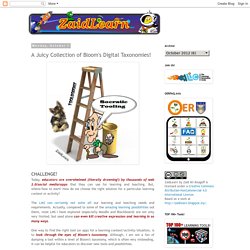
By thousands of web 2.0/social media/apps that they can use for learning and teaching. But, where/how to start? How do we choose the right solution for a particular learning context or activity? The LMS can certainly not solve all our learning and teaching needs and requirements. Actually, compared to some of the amazing learning possibilities out there, most LMS I have explored (especially Moodle and Blackboard) are not only very limited, but used alone can even kill creative expression and learning in so many ways. Pinterest. חשיבה מסדר גבוה במעגל ההוראה.
Meyda.education.gov.il/files/Tochniyot_Limudim/Portal/EstrategyotChashiva. TaLe - Teaching and Learning exchange. TaLe - the NSW gateway to Primary, Secondary and TAFE teaching and learning resources.

Report all issues with TaLe service Report any issues within the DEC network via the usual feedback systems. Free App now available for download. Solve the mystery of the 'Real Heroes' on this Taronga Zoo - Rainforest Heroes app while exploring the zoo's stunning Wild Asia rainforest trail. This teacher professional learning (TPL) course will assist schools in preparing to implement new syllabuses by considering ways to plan and program for the needs of all students. Visit website This website provides support for schools in implementing the new NSW syllabuses for the Australian Curriculum.
70+ Web Tools Organized For Bloom's Digital Taxonomy. The number of web tools currently available to teachers, administrators, and students is downright absurd.
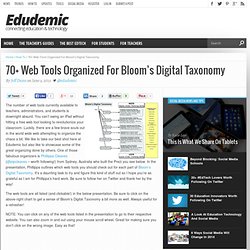
You can’t swing an iPad without hitting a free web tool looking to revolutionize your classroom. Luckily, there are a few brave souls out in the world wide web attempting to organize the chaos a bit. We like to take our best shot here at Edudemic but also like to showcase some of the great organizing done by others. One of those fabulous organizers is Phillippa Cleaves (@pipcleaves – worth following!) From Sydney, Australia who built the Prezi you see below. Bloomin' Apps. This page gathers all of the Bloomin' Apps projects in one place.Each image has clickable hotspots and includes suggestions for iPad, Android, Google and online tools and applications to support each of the levels of Bloom's Revised Taxonomy.I have created a page to allow you to share your favorite online tool, iOS, or Android app with others.
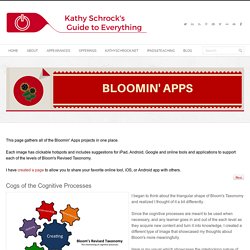
Cogs of the Cognitive Processes I began to think about the triangular shape of Bloom's Taxonomy and realized I thought of it a bit differently.Since the cognitive processes are meant to be used when necessary, and any learner goes in and out of the each level as they acquire new content and turn it into knowledge, I created a different type of image that showcased my thoughts about Bloom's more meaningfully.Here is my visual which showcases the interlocking nature of the cognitive processes or, simply, the "Cogs of the Cognitive Processes". Ol Tools for 21st Century Learners: Flexible Learning Paths. 3 Ways to Encourage Higher Order Thinking with Technology - Getting Smart by Susan Oxnevad - blended learning, common core, digital learning, EdTech, Innovation.
As a teacher, I relish the days of summer because I am given the opportunity to learn, rethink, design, and fine tune my teaching with the hope of being able to inspire students and teachers in the coming school year.
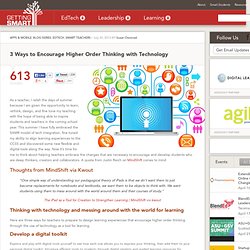
This summer I have fully embraced the SAMR model of tech integration, fine tuned my ability to align learning experiences to the CCSS and discovered some new flexible and digital tools along the way. Web-based Version of Blooms Taxonomy (30+ digital tools ) Storytelling. Web Tools to Use with Bloom's Digital Taxonomy.
Web Tools to Use with Bloom's Digital Taxonomy. Bloom's Taxonomy Resources. Bloom’s Taxonomy can be a powerful tool to transform teaching and learning.
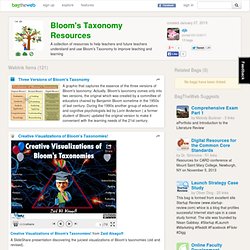
By design, it focuses attention away from content and instruction, and instead emphasizes the “cognitive events” in the mind of a child. And this is no small change. For decades, education reform has been focused on curriculum, assessment, instruction, and more recently standards, and data, with these efforts only bleeding over into how students think briefly, and by chance. This means that the focus of finite teacher and school resources are not on promoting thinking and understanding, but rather what kinds of things students are going to be thinking about and how they’ll prove they understand them. This stands in contrast to the characteristics of the early 21st century, which include persistent connectivity, dynamic media forms, information-rich (digital and non-digital) environments, and an emphasis on visibility for pretty much everything. Bloom's and ICT tools.
Many teachers use Bloom's Taxonomy and Bloom's Revised Taxonomy in developing and structuring their teaching & learning experiences.

Bloom's Digital taxonomy is an attempt to marry Bloom's revised taxonomy and the key verbs to digital approaches and tools. This is not a replacements to the verbs in the revised taxonomy, rather it suppliments and supports these by including recent developments, processes and tools. Learning and Teaching Blog. Fourni par Traduction DOWNLOAD THE LATEST VERSION: V4 published Mar 2015.
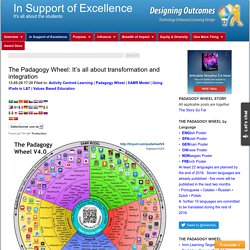
This PDF Poster has links to 122 of the latest and most popular educational apps. Now these resources are available in 19 different languages. The poster also has app selection criteria according to Blooms taxonomy. V4.0 was published in March 2015 but I knew I was onto something useful when I first put the Padagogy Wheel together in July 2012.
So why the need for Version 2.0? We need to have transformation at the core of what we do: If it is all about the students, where do you start with curriculum and/or teaching design – surely it is with what do you want your graduates to look like? Bloom's Taxonomy for 21st Century Learning.